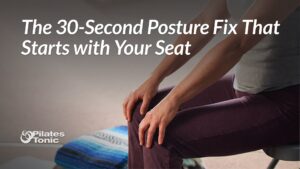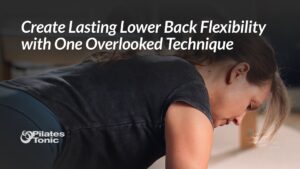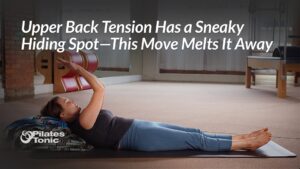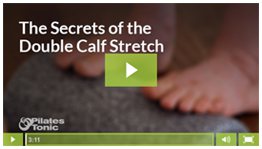Your body adapts to the way you use it every day.
For example, when you walk, your hip flexors stretch to one length and, when you sit, they become dramatically shorter. This flexibility according to need is very important.
If you spend a lot of time sitting every day, your body eventually learns that you don’t need the hip flexor length optimal for walking and, to conserve energy, it literally shortens your hip flexors in a process called sarcomerolysis.
While it’s amazing that the body conserves energy automatically by lengthening and shortening and adapting to how you spend the most time, it’s not so great when it comes to alignment and body function
For instance, take those shortened hip flexors that have adapted to sitting, they no longer have the length necessary to walk efficiently and will inhibit your glutes from participating. This means your hamstrings and low back will have to work overtime when you walk.
The good news, if you think you have shortened hip flexors, is that as long as you are alive, your body continues to adapt. If you change your behavior, your body will learn and adapt. With specific action and continued commitment, you can regain optimal length in your hip flexors!
Here are three actions you can take immediately:
- Stop sitting for long periods of time. If work requires you to be in front of a computer for long stretches, change up your work station. Create a workspace that allows you to stand and/or kneel in addition to sitting.
- Take frequent breaks to get up and walk around and stretch.
- Stretch your hip flexors regularly while maintaining a neutrally aligned pelvis.
Today’s video takes a familiar hip flexor stretch and changes it up in subtle ways to help you open and release areas you probably haven’t visited before.
Check the video and let me know what you think! If you try this stretch, I'd love to hear how it goes in the comments below.
Happy hip flexor stretching!
Sydney
References:
- On high heels and short muscles: a multiscale model for sarcomere loss in the gastrocnemius muscle.
Zöllner AM1, Pok JM1, McWalter EJ2, Gold GE3, Kuhl E4 - Move Your DNA by Katy Bowman, Pages 69-70





14 Responses
Hi! I have BIG issues with lumbo pelvic instability, SI, knee, and L5 pain, etc. This stretch should help me, if I do it right. You said the pubic bones should be in a vertical plan. My biggest issue is that my right ilium is WAY higher than my left ilium when I put my right foot forward, and viceversa. What’s going on? Is that ok? they’re both forward, and in line with my pubic bone, but it’s just one is higher… Thanks!
Hi Ashley, without seeing you it’s difficult to say specifically what’s going on with your right side, but as long as your ASIS (bony landmark at the front of your ilium) are aligned with your pubic bone in the frontal plane you should be good, even if one ilium is higher toward your armpit. When stretching your left side think about dropping your right sitting bone toward the floor. That can help level out the top of the hips in this stretch. Hope this helps. I’d love to hear how it goes!
Thanks! It happens on both sides. But, it sounds like ideally both ASIS should be level horizontally, but it’s ok if they’re not in the beginning? Do I understand that right? Thanks again. You really have a quality educational resource here.
Ideally both ASIS will be level, but if they aren’t in the beginning it’s okay. As long as your pubic bone is not in front of, or behind your ASIS, you’re going to get a safe and efficient stretch. Dropping the sitting bone of the side not being stretched will help with leveling the tops of your hips. You can use your ASIS as markers to mark your progress. It will be fun to see if you can level them as time goes on. Thanks for your feedback!
Did you make this video just for me? I’m kidding, but this series is EXACTLY what I need. You explain the pelvic and rib alignment so well!
All the kneeling stretches that require pushing back onto the toes make me think that my feet are not very flexible. I guess I should be working on that, too.
Hi Molly, I’m so glad you enjoyed the video! You are spot on about foot mobility. Most people have very tight and immobile feet from wearing shoes. These two videos help with increasing foot mobility.
How to Reactivate the Natural Spiraling Motion of Your Feet
This Foot Exercise Will Actually Release Muscles from Head to Toe
Thanks for your feedback!
Following up: I did both of those foot exercises before trying the hip flexor stretch again. It was much easier to bend back my toes this time, and I was able to focus on my hip alignment more closely. Thank you, Sydney!
That’s fantastic Molly! Thank you for sharing your feedback!
I can only feel the strech in the back leg, in the upper section between the knee and hip. Is that right?
That’s perfect Simon, exactly where you are supposed to feel this stretch. Thanks for your question!
Hi Sydney. I love these hip exercises as I sit for long periods. Can I do all of your hip flexor exercises safely as I have a complete hip replacement?
Hi Rebecca, Great question! In the kneeling hip flexor stretch demonstrated in this video, I would avoid taking your foot out to the side of your body as this internally rotates your femur. Otherwise, the other hip flexor stretch variations are fine and safe for a total hip replacement, but I would recommend checking with your doctor or physical therapist first to ensure this is a good choice for you. Thanks for your question!
Hi Sydney, I have an old Judo injury that it still bothering me from time to time. It happened when I arrived late for warmup and started to stretch a cold muscle. My left leg was Abducted out to the side and I know I over stretched it as I heard a popping sound. It’s been almost 10 yrs. later and I started a Adult ballet class and when I stretched my right leg out to the side and a little high, I experienced incredible pain in doing so. Will this old injury ever get better & what do I do to help it so I’m not injurying it all over again.
Thanks so much,
Kimberly
Hi Kimberly, Without seeing you it’s difficult to give specific suggestions. That said, the information in this post by Katy Bowman and the exercise she demonstrates at the bottom of the post would be a good place to start. Hope this helps and thanks for your comment!